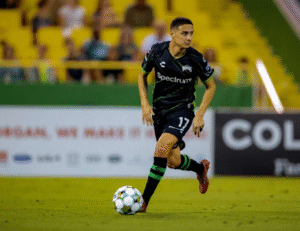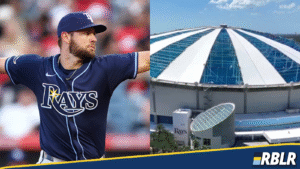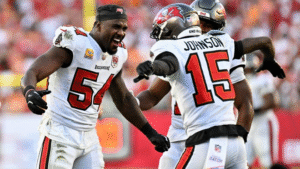Inside the Rays’ Homegrown Machine: BA’s Top 5 Picks

Baseball America is viewed as quite possibly the most reputable talent evaluation services across the major media platforms. Today, we will go over what they perceive to be the Rays 5 best up-and-coming farmhands.
Carson Williams: #1 in Rays Org, #32 overall, and #12 among SS:
In his 5-year professional career, Williams has breezed through every level, consistently sustaining a wRC+ of anywhere from 125 to 142, but it seems he has hit a bit of a roadblock in his first full season in AAA. Williams’ bat has been ice cold much of the season; he ranks in the 20th percentile in wRC+ amongst qualified international league bats and is striking out a career worst 35.2%. What is the issue?
The performance vs Breaking pitches: Williams has struggled vs spin this season, he is whiffing at a 51.2% rate, which would place him in the ~2nd percentile in Major League Baseball if that rate sustained at the next level. The quality of contact vs spin is pedestrian as well, Williams is only producing a 29% hard hit% (~30th ML percentile), well below his overall season number of 41%. Although it is an extremely small sample size, Williams is handling spin much better in June, cutting his whiff% down 11.2% to a much more palatable 40% (~20th ML percentile). Overall, if this improvement sustains, that will elevate his offensive ceiling and overall plate profile immensely.
Xavier Isaac: #2 in Rays Org, 76th overall, and #5 among 1B:
Isaac is off to a very productive season, sporting a 160 wRC+ and tying him for 3rd with Biscuits teammate Tatem Levins. It is easy to get excited for the 21-year-old Isaac, who is -2.7 years below the average age for the Southern League, and has already flashed a max exit velocity of 117 this season, but there have still been some speed bumps along the way.
The contact dilemma: Entering his 4th professional season, Isaac had a lot of evaluators questioning if he’d make enough contact to ever make it to the major leagues. The 20-year-old (at the time) Isaac sported a Southern League worst 40.6% K% last season, and a 55.9% contact%, which would rank last at the major league level. Isaac has made some noticeable improvements, opening up his stance in a pretty extreme way this season, and so far, it is paying off. Isaac has increased his contact% by 5.8% this season to a still last place 61.7%, but just 0.1% behind Guardians infielder Gabriel Arias. The opening of Isaacs’ stance is proving to pay huge dividends thus far, and hopefully this improvement sustains.
Theo Gillen: #3 in Rays Org, #79 overall, and #13 among OF:
With their 18th pick in the 2024 draft, the Rays selected Theo Gillen. Rays director of amateur scouting Chuck Ricci had this to say shortly after selecting Gillen: “I think the No. 1 thing we like is his makeup, his maturity — and his bat-to-ball skills.” Gillen has proven what Ricci has said to be true about him so far. In a league where Gillen is 1.5 years younger than the average player, he is producing among the best in the entire league, ranking 7th in wRC+ with a 161 mark. Gillen is putting his maturity and bat-to-ball skills Ricci spoke highly of, on full display, ranking 21st in BB/K ratio. Theo was also awarded Tampa Bay Rays Minor League Player of the Month after slashing .309/.468/.549 in May.
Gillen’s bat-to-ball excellence: Most talent evaluators project Gillen to be a 60-hit tool in the long run, and he’s already showcasing that potential in Charleston this season. Gillen is maximizing his profile quite well thus far, ranking 6th in LD% and 19th in SwStrk%, consistently showing off, game to game, his unique feel to hit for such a young player. This plus feel to hit at such a young age, certainly projects Gillen to move rather quickly through the Rays system.
Chandler Simpson: #4 in Rays Org, #84 overall, and #15 among OF:
Rays fans are more than familiar with Simpson, as he has already logged 133 plate appearances in the majors this season. The speedy Simpson flashed his elite speed time and time again, generally jostling with Reds SS Elly De La Cruz for the stolen base lead after the day he was called up. On May 30th, Simpson was controversially optioned down to make room for outfielder Jake Mangum. Efficiency plagued Simpson throughout his major league opportunity; he ranked near the bottom in OAA, posting -3 across his 284 innings of work, and struggled with offensive efficiency, posting an 84 wRC+.
Can he become more efficient? Rays President of Baseball Operations, Erik Neandner, put it best: “Chandler is going to hit .300 in the big leagues, but what ultimately determines his impact is will it be accompanied by a .320 on base or a .360+”. In his extended Major League stint, Simpson landed in the 11th percentile in BB%, and landed in the 50th percentile in OBP, getting on base at a .315 clip. Even back to his college days, Simpson generally landed in the 90th percentile in chase%, so to see him fall into the ~30th percentile in chase% was quite surprising. Neander truly said it best, explaining why the move was made: if Simpson can become more efficient on the offensive side of the ball and tap into his lofty defensive ceiling, the Rays will have a potential star on their hands.
Brayden Taylor: #5 in Rays Org:
Taylor was the lone omission out of the 5 players we have gone over from Baseball America’s June top 100, and for good reason. The Rays 2023 first-round pick has stalled out in AA. In his first 324 plate appearances, he has compiled a lofty 32.4% strikeout rate and has slashed a pedestrian .188/.282/.358.
Why the contact issues? Taylor has an extreme swing. Last season, according to FanGraphs, his average launch angle was 24°; the only qualified major leaguer with a greater launch angle is Red Sox outfielder Wilyer Abreu. Taylor has made a substantial boost in contact% in comparison to his first stint in AA, increasing it by +6.3%, but it remains a pretty low 71.5%. The biggest concern is that his biggest struggle is handling velocity. These contact concerns really dampen Taylor’s profile, as most evaluators tend to think he’s anywhere between a 50 to 55 grade defender and only possesses 50 grade raw power.
This Rays system is the deepest it has been, maybe ever? There were so many omissions you could have easily argued for any of these top 5 spots, including: Aidan Smith, Brody Hopkins, and plenty of others. The consistency within the draft process is what is most impressive. All five of these players listed here were all drafted by the Tampa Bay Rays, including their last four first-round picks. The Rays draft focus of looking for guys with loud tools and traits is paying off, and I am very excited to continue tracking the development and growth within this system.







